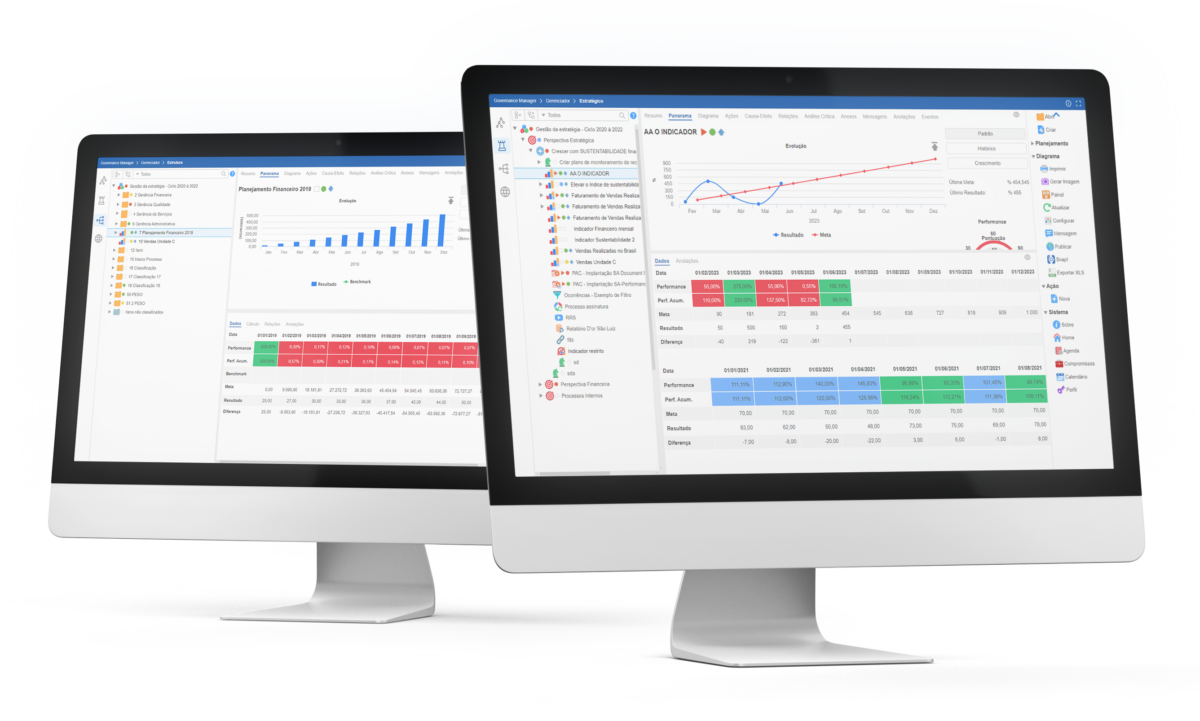
The Interact Suite SA emerged from the Balanced Scorecard (BSC), and such was the identification that the SA Governance Manager module is based on this methodology. The BSC is a management tool based on an organizational model called Strategy-Focused Organization.
More than just a tool, the BSC is a strategic management model created to demystify the notion that, to succeed, a business needs to focus solely on financial and accounting indicators. While the ultimate goal of companies is to achieve positive financial results, focusing exclusively on this may not work. It is necessary to have a solid strategy and business approach for the outcome to be positive. For example, when we want to buy a car, it is not enough to focus solely on the amount required for the purchase, but rather on strategies to reach that amount and result in the purchase of the desired asset.
Your organization is based on four perspectives: financial, customer, internal processes, and innovation and learning. By encompassing other angles, it motivates non-incremental improvements in critical areas such as product development, processes, customers, and markets.
Explore the perspectives:
– Financial:
Shouldn’t we focus exclusively on the outcome without a strategy, right? It is in this perspective that we will establish financial objectives and strategies, after all, every business needs money to sustain its activities.
Evaluate and list the company’s short, medium, and long-term financial objectives. It is important to align the expectations of all partners or investors and find a balance between divergences.
To project objectives, it is important to analyze metrics and reports such as ROI, lifetime value, customer acquisition cost (CAC), average ticket, and churn rate. Additionally, consider other metrics related to your niche or market segmentation.
– Customers:
Just like in other methods that consider customers highly important, the BSC also reserves an exclusive perspective for customer relationships and market share.
Strategies are devised so that actions are immediate and results are reaped over the years, as solid relationships are built over time and based on trust.
It’s necessary to observe customer retention and acquisition, as well as the profitability of your customer. All of this will also be aligned with financial objectives because to achieve them, it’s necessary to fully meet the needs of customers, as well as the other perspectives to follow.
– Internal Processes:
After covering the financial area and the customer perspective, it’s time to look at internal processes with the aim of identifying those that have the most impact on the business and which points can be improved.
Continuous improvement ensures the quality of internal processes, which need to be increasingly accurate to ensure customer satisfaction and, consequently, the achievement of financial goals.
When looking at internal processes, it may be necessary to create new ones so that the strategy is even more aligned with the purpose and other perspectives. Pay attention to numbers and analyses regarding productivity, speed of customer service, compliance, innovation, among others.
– Innovation and Learning:
All the previous perspectives are carried out by people, so keeping the culture of innovation alive and encouraging the pursuit of new knowledge is essential.
This perspective of the BSC represents the knowledge and experience necessary for the company to achieve its goals and maintain a constant growth curve.
Evaluate and, if necessary, invest in training and development, create a corporate culture and assertive communication, promote initiatives that keep employees satisfied, and always be attentive to the results of the organizational climate.
Benefits of BSC
O BSC provides a simple and intuitive view of the most important aspects of strategic planning, facilitating the understanding of the main goals and objectives of everyone in the company through the strategic map.

And speaking of the map, this can be updated as needed, maintaining continuous improvement and seizing opportunities.
By meeting goals and objectives, the company can renew the framework as a performance optimization tool that will never become obsolete.
Another competitive advantage of using this management model is its ability to unite tangible and intangible indicators in the same strategy. Additionally, it allows for alignment between strategic indicators of areas and corporate indicators, optimizing actions and strategy alignments.
SA Governance Manager
As mentioned earlier, the SA Governance Manager module is based on the Balanced Scorecard. It is a fundamental module for corporate governance, and when integrated with the other modules of the Interact Suite SA, it performs excellently in achieving management excellence.
With it, companies can fully structure their strategic and operational planning aligned with the BSC. It also allows for the management of OKRs (Objectives and Key Results) and integrated management of critical analysis events.
Its applications enable the construction of Governance 4.0, strategic and operational management, construction and visualization of the strategic map, elaboration and monitoring of action plans, managerial analysis, and interactive dashboards.
And, to complement your management, Interact offers complementary tools such as BAM Analysis, Why Analysis, SWOT Analysis, Presenter, Digital Signature, Bow Tie, Layers of Defense, Dashboards, Ishikawa Diagram, Risk Map, Project Canvas, Scrum, Kanban, among others.
Visit our website and learn more.
Author:

Bianca Wermann
Journalist, Communication and Marketing Analyst at Interact Solutions



